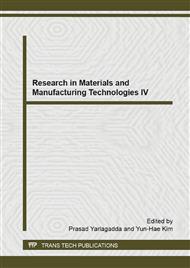p.471
p.475
p.481
p.492
p.497
p.507
p.511
p.515
p.522
Research on Helical Milling Specialized Tool Based on Chip-Splitting Mechanism
Abstract:
Compared with conventional push drilling, helical milling (orbital drilling) shows great advantages in aeronautical hard-machining materials hole making. However, helical milling of titanium alloy and carbon fiber reinforced plastic (CFRP) under dry cut condition still faces challenges such as burr of titanium alloy hole exit and CFRP hole delamination. In order to solve these problems, an innovative helical milling tool with distributed multi-point front cutting edge is designed based on the chip-splitting mechanism and tool movement feature. The description of cutting edge movement track and simulation of chip shape is used to analyze different functions of front and peripheral cutting edges, the chip-splitting result and the specialized tool's service life. The helical milling experiments are aimed to test the performance of the specialized tool compared with that of traditional end mill. Results show that the specialized tool can machine titanium hole free of burr and CFRP hole without delamination under dry cut condition. The specialized tool has a longer service life with its machining capacity amounting to 80 titanium holes and 65 CFRP holes..
Info:
Periodical:
Pages:
497-506
Citation:
Online since:
December 2014
Authors:
Price:
Сopyright:
© 2015 Trans Tech Publications Ltd. All Rights Reserved
Share:
Citation:


